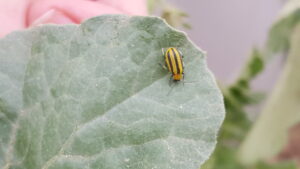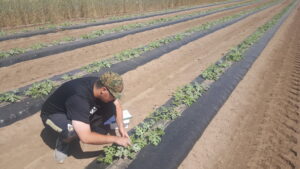While in your fields in the last week you may have noticed fewer striped cucumber beetles on the leaves and stems of the growing cucurbit plants (Figure 1). This is because there are two generations of this pest in Indiana; the 1st generation adults that overwintered in the field have mated and left behind their eggs in the soil around the crop roots. When these eggs hatch the cucumber beetle larvae will feed on plant roots until they pupate into adults and emerge as the second generation typically in early July. Fields in northern Indiana will likely be 1-2 weeks behind on the second-generation emergence compared to southern regions of the state.

Figure 1: Striped cucumber beetle feeding on newly transplanted watermelon. The first-generation beetles can occur in high enough numbers to stunt plant growth or kill the seedling outright.
This means that while you still may see adult striped cucumber beetles in your vegetable fields, they are likely not going to be found at high enough populations to cause economic damage (1 beetle per plant in cucumbers and cantaloupes and 5 beetles/plant in other cucurbits) and insecticide sprays will not likely prevent any yield loss. In fact, as the early planted cucurbits begin to produce flowers the application of insecticides may be repellent or harmful to pollinators and reduce early fruit set. Weekly scouting during the time between generations can inform pest management decisions. Looking for pests on 8-12 plants across of few rows in your field (Figure 2) should give an accurate picture of average pest populations to determine if action is needed.

Figure 2: The author of the article is scouting watermelon plants for striped cucumber beetles and other pests. This can be a cost-effective way to avoid unnecessary sprays that could harm beneficial insects.
If sprays are necessary to respond to high cucumber beetle numbers, apply as late as possible in the evening to avoid times of pollinator activity. For smaller growers, research has shown that applying entomopathogenic nematodes (EPNs) to the base of the plant can reduce the population. EPNs are microscopic organisms that live in the soil and feed on a variety of soil-borne insects. Steinernema carpocapsae and Heterohabditis bacteriophora have been shown to be effective when applied in summer. Both can be purchased from a variety of biological suppliers, see article Considerations and Suppliers for Biological Control published in Issue 616 of Vegetable Crops Hotline Newsletter for some options. Monitoring pest populations in vegetable fields and applying pesticides in a conservative manner is an effective way to reduce harmful exposure to pollinators and other beneficial insects.
Consult the 2020 Midwest Vegetable Production Guide for Commercial Growers at www.mwveguide.org for management options. When applying foliar spray during bloom be sure to apply in the evening when flowers are closed and fewer pollinators are active in the field to avoid exposure to beneficial insects.